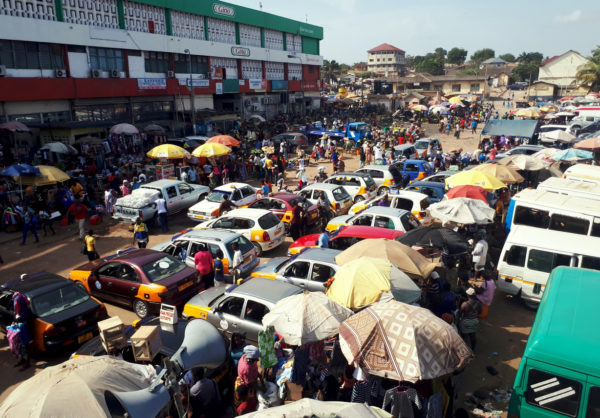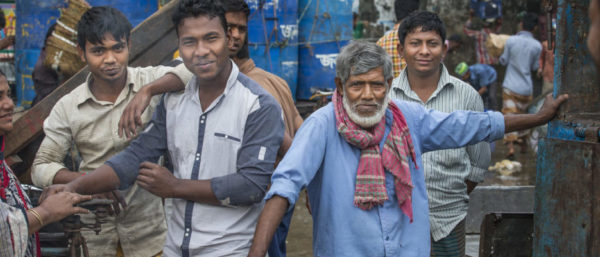Is migration an untapped resource in transformations to sustainability?
This interview with Neil Adger, one of the Principal Investigators of the MISTY: Migration and Sustainability project, explores some of the connections between migration, cities and sustainable development. This piece has been reposted from the T2S research programme website.
Why is migration so important for transformations to sustainability?

The world is becoming a lot more mobile: it’s one of the current great transformations. Yet theories of transformation often emphasise social, political and economic change without mentioning that people are moving around all the time. As many as one in seven of the world’s population can be considered a lifetime migrant – someone who has moved their place of residence for a distance and a duration long enough that most offices of national statistics would regard them as migrants. Virtually three quarters of that kind of migration is within countries, often people moving to cities, which is one the main drivers of urbanisation.
The way researchers think about migration and mobility has also changed in recent decades to incorporate dimensions beyond the dominant idea that people move from one place to another to get better economic opportunities. That’s one of the reasons people give for why they move: to get better opportunities for themselves and for their families. But migration is also conceptualised as a social transformation that affects people’s identity and life course.
Many of the big structural changes people make to their lifestyles tend to take place at very specific stages in their life course – for example becoming an adult, moving to find work, or forming a household. They’re often moments when people reinvent their identities, to some extent, and change their habits and behaviour – for example changing to behaviours that are more sustainable, or less so. Quite often those stages are marked by movement from one place to another.
The MISTY project focuses on migration and sustainability. Can you tell us more about the questions it will address?
MISTY explores the idea that migration is a missing variable in trying to understand transformations to sustainability: from the point of view of the resource implications of people moving around, and of urbanisation, and the role of migration itself in social transformation.
We have three themes: one is to look at the sustainability implications of the world becoming more mobile by using data on where people are moving, both internationally and within countries, to examine the effects of those movements for resource use and the environment.
What are the sustainability implications of people moving from rural areas to urban areas within an emerging economy such as India, China or Bangladesh? In urban areas there are the opportunities to provide services at scale, such as public transport, but does that mean that urban living is more environmentally efficient than rural living, or is it vice versa?
These are open empirical questions and it really depends where in the world you are. That’s part of the MISTY project: looking at these patterns and developing a conceptual model of the interaction between migration and sustainability, and calibrating that with data about migration flows everywhere in the world, including international and domestic migration.
The second theme is to look in depth at the single largest flow of people globally, which is the flow of people to cities. That principally happens within countries but also includes some international migration.

The MISTY project is collecting comparative data on migration experience in six cities globally: in Worcester (USA), Brussels, Amsterdam, Maputo, Accra and Dhaka. Some of those cities are dominated by international migration and some by domestic migration. The list also includes cities that have issues of social exclusion and high levels of insecurity and precarity for migrants, as well as places that have international flows of high-skilled migrants. If we consider cities as the crucible for sustainability, we’re using multiple methods to look at the migrant experience within cities, and their behaviour and identities and how that interacts with sustainability.
One of our underlying theses is that new migrant populations into cities are an untapped resource towards transformations to sustainability. If people do not feel attached to the places that they have moved to, they are less likely to invest in the sustainability of their destination. In other words, our hypothesis is that that sustainability depends on the effectiveness and the speed at which new migrant populations are integrated into cities and into planning for urban sustainability.
Our third theme is about governance, both at the global and the national level. Migration is a highly politicised area in all parts of the world. Over the last couple of decades, a lot of the discussion about migration has become securitised, with a major focus on international and irregular migration. There’s an idea that migration is something undesirable that threatens social cohesion or territorial integrity. Migrants tend to be more socially marginalised and excluded, and so the idea that integration of migrant populations can be beneficial for sustainability is politicised.
We’re looking at how migration is treated within environmental governance, and how environmental issues are incorporated into discussions about the global governance of migration, such as in the Global Compact for Migration.
In a recent piece published in the Lancet Planetary Health, you argue that migration could be transformative for achievement of the Sustainable Development Goals (SDGs). Could you tell me more?
Migration is largely invisible in the Sustainable Development Goals (SDGs), which only really refer to international migration and to the economic dimensions of migration. The SDG targets and indicators reference the benefits of migration in terms of the flow of remittances back to source countries as a way to mobilise financial resources for developing countries.
We’re not trying to propose more indicators, goals and targets, rather we’re saying that understanding the social processes that underpin some of the SDGs would go a long way to helping achieve them. For example, with reference to SDG 11 (Sustainable cities and communities), recognising that a lot of the people living in rapidly growing cities weren’t born there and are insecure there – and are still deciding on whether or not they’re going to stay there – would change priorities for urban planning.
MISTY has been going for about a year. What have you found out so far?
We’re just about to complete the first of three phases of data collection, which has involved in-depth research with a small cohort of lifetime migrants in the six cities about their own perceptions of sustainability. We will use this data to both explore whether the common process of movement affects how people integrate and buy in to their new places. And we will also explore differences in perceptions of sustainability of these new migrant populations across a wide variety of cultural and political contexts. Watch out for our results.
We are currently designing more extensive survey research, to test hypotheses about changes in behaviour throughout the life course. One of the well-established findings in migration research is that people converge to the mean: people alter their identities and essentially adopt the culture of the places they move to. As an example, someone living in a European city may already have a relatively high environmental footprint, but if they were to move to Los Angeles, their environmental footprint would probably escalate three or four times, even if they don’t change their values or worldview, just as a reflection of the geographic realities of the economy in Los Angeles. The survey research is, among other things, looking at whether or not people change their behaviours and lifestyles and how they conceptualise environment and sustainability in the places that they move to.
The third set of data collection we’re doing involves getting groups of new migrants in each of the cities to engage with and work directly with urban planners, to incorporate new migrants’ voices and perspectives on sustainability in planning processes in their new cities.

We can’t yet share the results from the first phase of research, but previous research in Chattogram, the second city of Bangladesh, with low-income, low-skilled and highly insecure migrants, found that the principle concerns are around insecure and precarious housing, but also around the impact of environmental risks on health. Those concerns are principally around environmental hazards, but also around the long-term health risks of living in cities. The results may obviously be very different in different cultural contexts, and that’s something MISTY will explore across the six different cities globally.
What’s next for MISTY?
In February 2020 the Consortium will meet in Ghana, hosted by one of our principal collaborating teams, which is led by Sam Codjoe. There we will continue to analyse our initial dataset on how self-identified migrants think about and scope out sustainability in their new cities and places.
We’re also engaging with other parts of the research and policy community. Our commentary on the SDGs was published in collaboration with the project called Global Goals at the University of Utrecht, which is looking at the global governance of the SDGs. Our colleagues from the Hugo Observatory in Liege are currently working with the C40 group of cities, and their partner The Mayors Migration Council.
The MISTY work has also spun off into other synergistic activities on migration and sustainability. We’ve just received funding from the Wellcome Trust ‘Our Planet, Our Health’ programme for a project with the University of Ghana and other collaborators to incorporate health into adaptation to climate change. We are doing what we can to bring the idea of a mobile and dynamic world, where people and ideas are not static, as a force for good in the necessary transformations to sustainability.